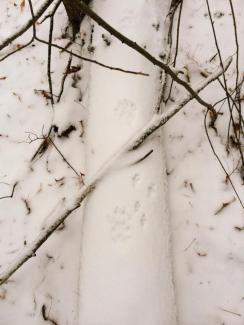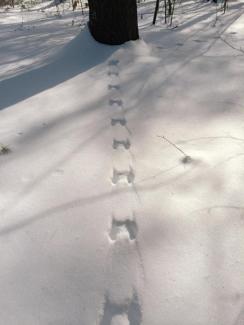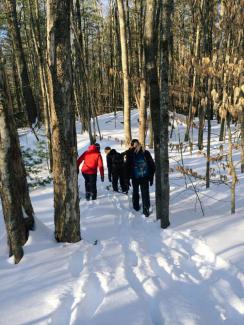Stewardship Tip: Wildlife Tracking
A Stewardship Tool Only Winter Provides
There’s more stewardship work to be done in the winter than you might imagine. The frozen ground provides a good opportunity for certain types of management like timber harvests and wildlife habitat management. It is a great time to learn more about the land you care about and the wildlife who use it.

While some animals hibernate through the cold winter, much of our wildlife remains active year round. One benefit of snow on the ground is that wildlife leave their tracks behind for us to observe!
Learning how to identify common wildlife tracks is a good reason to get outside in the winter, provides a window into the lives of wildlife we don’t often get to see, and can help inform stewardship of the land you care about. Whether you’re stewarding a small property or looking at a larger landscape, wildlife tracks can help direct your stewardship actions. Here’s how:

Who’s on the land? Identify common wildlife tracks. If not for winter, it would be easy to assume animals you don’t see aren’t using the lands you care about. However, animals that are nocturnal and/or secretive still leave their tracks in the snow. Wildlife tracks will tell you what wildlife species live in the area.
How are they using the land? Observe the surroundings where you find tracks. Once you figure out what species of wildlife are on the land, pay attention to where their tracks are found. Are the red fox tracks always at the edge of a field? Does the bobcat spend a lot of time near swamps or rocky outcrops? Are the porcupine tracks mostly found in hemlock stands? Where you see tracks will give you clues to what areas might be important to certain species and help inform management decisions.

Where are they going? Follow wildlife tracks across the landscape. Following wildlife trails across land over time will give you an idea of how animals use the larger landscape. This is useful information for forest management decisions and conservation efforts. If you were to plan a new trail, for example, you could avoid sensitive areas where a lot of animals pass through.
Remember, the more time you spend observing wildlife tracks, the more you’ll learn about the land! If you’d like to learn more from others, join us for upcoming workshops or read below for recommended resources.
If you're interested in looking into wildlife tracking on your own, here are some recommended resources on tracking:
Mammal Tracks & Sign: A Guide to North American Species by Mark Elbroch. Mechanicsburg, PA: Stackpole Books, 2010. (Amazon) (Local bookstores)
Tracking and the Art of Seeing: How to Read Animal Tracks and Sign by Paul Rezendes. New York: HarperCollins, 1999. (Amazon) (Local bookstores)
